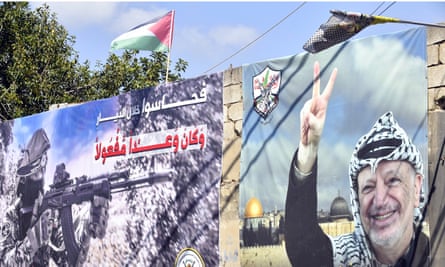Six weeks after the attacks of 7 October, with a punishing war in full swing, Jordan’s deputy prime minister issued a warning. “Hamas is an idea,” Ayman Safadi said. “It cannot be bombed out of existence.”
Despite seven months of bombardment – or perhaps because of it – Hamas is today one of the most important nationalist and Islamic movements in the world. Its enemies denounce it as the equivalent of Islamic State. Its supporters call it “the resistance”.
An offshoot of the Muslim Brotherhood that emerged from the refugee camps of Gaza in the 1980s, Hamas is an armed movement that seeks an independent and Islamic Palestinian state free from Israeli occupation. Its founders, such as the late sheikh Ahmed Yassin, were children of the Nakba, the Palestinian “catastrophe”, when about 750,000 people were forced from their homes in 1948 during the war that created Israel.
Though Hamas leaders first wanted to sow a “social jihad”, Islamising society to achieve their aims, the group embraced violence in the first intifada, seeing an opportunity to upstage Yasser Arafat’s secular Palestine Liberation Organisation and seize control of the uprising.
Its tactics have changed over the decades, but its ultimate aim has not. Hamas has used suicide bombers, rocket fire and even the ballot box to fight Israel and take power. In 2006 it won Palestine’s most recent elections. A year later, it seized control of the Gaza Strip. And last October, it staged an attack on southern Israeli communities in which it killed more than 1,100 people and took 240 others hostage. “Hamas can be excoriated,” warn Beverley Milton-Edwards and Stephen Farrell, “but it should not be underestimated.”
Milton-Edwards is a specialist in political Islam and the armed movements that grew out of it, from the Muslim Brotherhood to Hezbollah, and her advice has been sought on Middle Eastern security issues by a range of governments – European and Arab. Farrell, meanwhile, is a Reuters journalist with decades of crisis and conflict experience. Previously a Jerusalem bureau chief, Farrell has himself been kidnapped by militant groups.
Part history, part analysis, Hamas: The Quest for Power draws from the authors’ first-hand, on-the-ground research and reporting. Originally published in 2010 in the wake of Operation Cast Lead, a three-week war between Israel and Hamas in Gaza, this edition has been revised and updated throughout.
Milton-Edwards and Farrell interview Hamas figures of all levels of seniority. Some, such as Beirut-based leader Saleh al-Arouri, have since been assassinated.
Yahya Sinwar, the top Hamas leader in Gaza, now hidden in a labyrinth of tunnels and agonisingly out of reach for Israel’s military, meets one of the authors after his release from Israeli prison in 2011. Sinwar is said to have risen to prominence by rooting out collaborators before spending 22 years behind bars – time, he says, spent studying Hebrew and his enemy. “I am a specialist in the Jewish people’s history, more than many of them,” he says.
There are also encounters with Abu Obaida, the spokesperson for the Hamas military wing. His video statements on the latest developments in Gaza have made him the face of Hamas’s war – though a concealed one. He is known in Arabic as “the masked one”, notorious for always obscuring his face behind a red chequered keffiyeh twisted around his head. “It was difficult to know if it was always the same person or sometimes a body double,” the authors write.

Violent opposition to Israel is baked into the group’s identity, but is not, the authors argue, its raison d’etre. Do not mistake a milestone for a destination, they warn. To establish an Islamic Palestinian state, the ideologies of secular and leftist movements must be fought off as well.
From the outside, Hamas can seem paradoxical. Its 1988 founding charter is laced with blatant antisemitism, but its leaders met Israeli counterparts and proposed recognising Israel on its 1948 borders long before its secular rivals in the PLO. When Hamas decided to participate in the electoral system set up by the Oslo accords peace process, “its embrace of the ballot was intended not to end the violence but to ensure its continuance”, the authors write. Its military wing, the Qassam brigades, they note, is “at the same time both ultra-secretive and publicity hungry”.
There are also competing visions within Hamas about how to achieve its goals. Palestinian society is diverse, and Hamas is eager to present itself as a representative national movement. Its leadership, therefore, is broad and drawn from varied constituencies that range from Gaza to the West Bank, Israeli prison cells to the diaspora. Some Hamas leaders are presented by Milton-Edwards and Farrell as more “pragmatic”, others as more hardline or fundamentalist. Though it is tempting to imagine these divisions as being drawn between Hamas’s military wing and its more outfacing political bureau, the authors detail interesting tensions within the Qassam brigades soon after Hamas took control of Gaza. Mohammed Deif, the brigades’ shadowy leader and the architect of 7 October, returned to Gaza in 2007 to confront his “radical” lieutenants, who had gained power as he recovered from an Israeli attack. In private, the authors report, Deif bemoaned the Salafist radicalisation of his rivals, which he feared could be reputationally ruinous for Hamas by linking it to terror group al-Qaida.
The book traverses the movement’s history at a fast-paced clip, pausing occasionally for chapters that delve into specifics, such as its attitude to martyrdom or women, whom Hamas insists are involved in every level, but are also defined “principally through a biological function as ‘makers of men’”.
after newsletter promotion
The group’s origins are traced back to Izz ad-Din al-Qassam, the 1930s Syrian warrior sheikh, whose religious zeal and anticolonial militancy remain inspiration for the 30,000 fighters in the military wing that bears his name. Hamas is presented as a specifically “Islamist alternative” to Yasser Arafat’s Fatah, whose secular leaders had dominated the Palestinian cause but by the late 80s were living in exile, far from the daily struggles of Palestinians under occupation.
Hamas’s victory in the 2006 Palestinian elections was a watershed moment, creating a crisis by taking over Oslo-built, western-backed quasi-state institutions it had long undermined. Here, the authors credit Fatah ineptitude for the victory as much as Hamas’s potent organisational skills, though perhaps underplay its deft pivot to domestic issues such as corruption, welfare and service delivery.
They make a compelling argument that Hamas’s rise was aided by Israeli complacency, if not complicity. In the late 80s and early 90s, a blind eye was turned to inflows of cash from supporters abroad, and Hamas’s social projects operated undisturbed. “Israel regarded Hamas as a convenient foil to the PLO,” the authors write, hoping the newcomers could chip away at support for Arafat. Similarly, prime minister Benjamin Netanyahu has reportedly boasted that allowing Qatar to fund Hamas helped undermine the Palestinian national project by stoking divisions and separating authorities in the West Bank from Gaza. For Israeli critics of Netanyahu’s government, 7 October proved this policy a disaster.
When it comes to those Hamas-led attacks, the authors sensitively tiptoe through contrasting and highly charged views and narratives, balancing allegations and facts. The most brutal details are left to descriptions of bodycam videos taken from the bodies of slain Qassam fighters.
Before 7 October, the Palestinian national project was listing. A number of Arab countries had signed US-sponsored deals to recognise Israel, with Saudi Arabia expected to be next, dashing hopes of a region-wide peace agreement. Palestinian officials in the West Bank were seen as venal, at best, collaborators at worst, authorities whose security forces were working in lockstep with the Israeli military to enforce the occupation.
As intended, Milton-Edwards and Farrell write, Hamas’s attacks “shattered the status quo” and “smashed the myths that had scaffolded” the PLO’s political existence since Oslo. Inertia and relations with intransigent Israeli governments had yielded no progress towards independence for decades. The attacks also precipitated a war in which Israel has killed more than 36,000 Palestinians so far. Still, some opinion polls suggest enduring Palestinian support for the group. Though that may seem like another Hamas paradox, the values of steadfastness (sumud) and resistance (muqawama) in the face of an overwhelming Israeli enemy remain appealing. “Hamas has operated on a working assumption,” write Milton-Edwards and Farrell. “When Palestine burns, its support grows.”
Daniel Hilton is head of news at Middle East Eye
-
Hamas: The Quest for Power by Beverley Milton-Edwards and Stephen Farrell is published by Polity (£17.99). To support the Guardian and Observer order your copy at guardianbookshop.com. Delivery charges may apply
Source: theguardian.com


